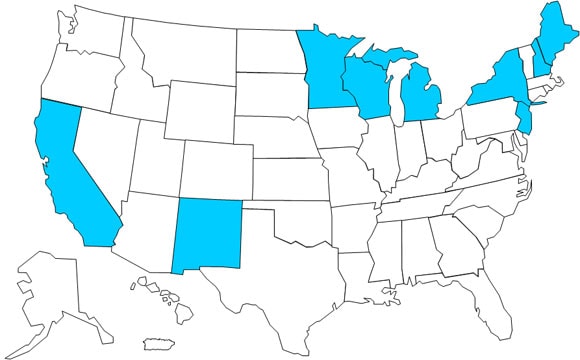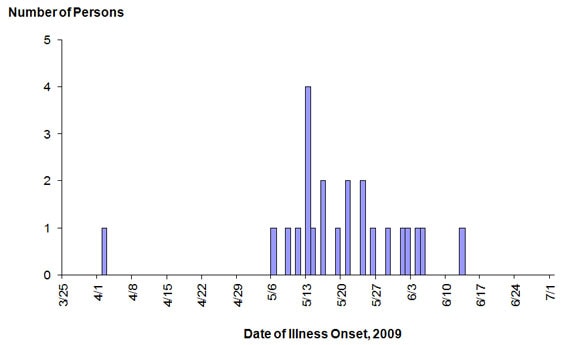Multistate Outbreak of E. coli O157:H7 Infections Associated with Beef from JBS Swift Beef Company (FINAL UPDATE)
NOTICE: This outbreak is over. The information on this page has been archived for historical purposes only and will not be updated.
Posted July 1, 2009
Outbreak Summary
Several state health departments, CDC, and the United States Department of Agriculture’s Food Safety and Inspection Service (USDA-FSIS) are investigating a multi-state outbreak of Escherichia coli O157:H7 infections. On June 24, FSIS issued a notice about a recall of 41,280 pounds of beef products from JBS Swift Beef Company that may be contaminated with E. coli O157:H7. On June 28, the recall was expanded to include 380,000 pounds of assorted pieces of beef (beef primal products) from the same company. Health officials in several states who were investigating reports of E. coli O157:H7 illnesses found that most ill persons had consumed ground beef, and many reported that it was undercooked. At least some of the illnesses appear to be associated with products subject to these recalls. Samples from unopened packages of ground beef recovered from a patient’s home were tested by the Michigan Public Health Laboratory yielded an E. coli O157:H7 isolate that matched the “DNA fingerprint” of the outbreak strain.
Twenty three persons infected with a strain of E. coli O157:H7 with a particular “DNA fingerprint” have been reported from 9 states. Of these, 17 have been confirmed by an advanced DNA test as having the outbreak strain; confirmatory tests are pending on others. The number of ill persons identified in each state is as follows: California (4), Maine (1), Michigan (6), Minnesota (1), New Hampshire (1), New Jersey (2), New Mexico (1), New York (1) and Wisconsin (6).
Most ill persons reported consumption of ground beef, and many reported that it was undercooked. Ground beef with the outbreak strain was obtained from the home of one person infected with that strain. The first reported illness began on April 2, 2009, and the last began on June 13, 2009. Among 17 ill persons for whom hospitalization status is known, 12 (70%) were hospitalized. Two patients developed a type of kidney failure called hemolytic uremic syndrome (HUS). No deaths have been reported. Of patients with available information, 14 (64%) were male and 59% are less than 19 years old (range 2 to 74 years).
Most of the beef packages in the first recall bear the establishment number “Est. 969” inside the USDA mark of inspection and have identifying package dates of “042109” or “042209.” Consumers are urged to check their refrigerators and freezers for beef products produced by this firm and purchased on or after April 21, 2009 and discard or return the recalled beef products to the place of purchase for a refund. The pieces of beef (primal beef products) in the expanded recall were produced on April 21, 2009, and were distributed nationally and internationally. Boxes of these pieces of beef bear the establishment number “EST. 969” inside the USDA mark of inspection, the identifying package date of “042109,” and a time stamp ranging from “0618” to “1130.” These pieces of beef were sold to retail stores nationwide after April 21, 2009, and some was probably cut again or made into ground beef, then re-packaged, so packages purchased by consumers may not have identifying information. Customers with questions about the source of a package of beef should contact the place where they purchased it (e.g., grocery store, club store, or meat market).
Advice to Consumers
Cook Beef Thoroughly
Eat ground beef or ground beef patties that have been cooked to a safe internal temperature of 160° F.
- Use a food thermometer to measure the internal temperature—it is the only way to be sure ground beef is cooked to a high enough temperature to kill harmful bacteria.
- Color is NOT a reliable indicator that ground beef or ground beef patties have been cooked to a temperature high enough to kill harmful bacteria such as E. coli O157:H7.
Refrigerate Meats
- Refrigerate raw meat within two hours after purchase or within one hour if temperatures exceed 90° F.
- Store ground beef in a refrigerator set at 40° F or below, and cook or freeze it within one or two days of purchase
- Refrigerate cooked meat and poultry within two hours after cooking, and use or freeze it within three or four days
Consumers who have questions about the recalled products can contact USDA-FSIS at “Ask Karen” online at www.AskKaren.govExternal
Final Case Count Map
Persons infected with the outbreak strain of E. coli O157:H7, by state of residence, as of June 30, 2009 (n=23)

Twenty-three persons infected with a strain of E. coli O157:H7 with a particular “DNA fingerprint” have been reported from 9 states. Of these, 17 have been confirmed by an advanced DNA test as having the outbreak strain; confirmatory tests are pending on others. The number of ill persons identified in each state is as follows: California (4), Maine (1), Michigan (6), Minnesota (1), New Hampshire (1), New Jersey (2), New Mexico (1), New York (1) and Wisconsin (6).
Final Epi Curve
Infections with the outbreak strain of E. coli O157:H7, by illness onset*

*n=23 for whom information was reported as of June 30, 2009. Some illness onset dates have been estimated from other information.